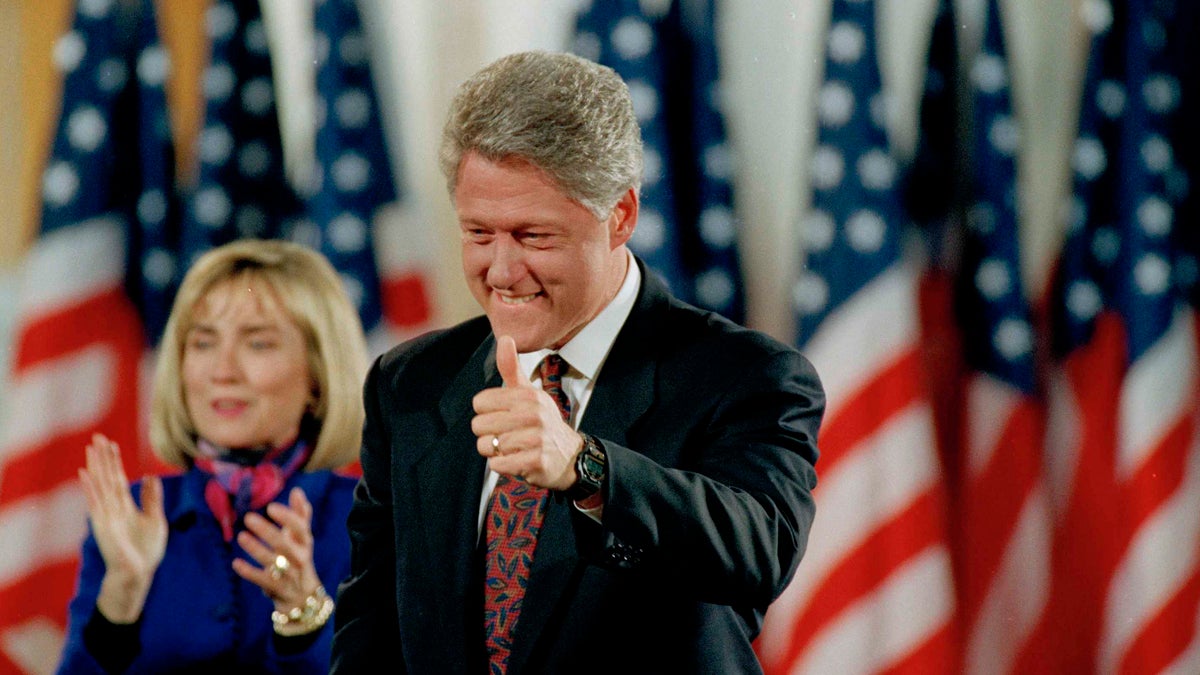The Clinton archives: Advice on being ‘real’

Bill and Hillary Clinton are shown the day after the 1992 presidential election in Little Rock, Ark. (AP Photo/Doug Mills, file)
We’re always pining for authenticity, searching for candidates who are willing to reveal their true selves. The problem is, how do we know when we’re getting the real thing? What if the purportedly true self is just another layer of packaging?
I mulled those old questions anew this weekend, while grazing the materials released on Friday by the Bill Clinton presidential library. I didn’t read all 4,000 pages of the previously confidential Clinton cache – life is too short – but one particular memo (on page 86 of this trove) made a big impression. It was written in July 1999 by Mandy Grundwald, an adviser on Hillary’s nascent Senate campaign. Hillary was due to announce her candidacy, and face the media, at a New York farm. Grunwald offered her “a few style pointers.”
For instance: “It’s important that your tone stay informal and relaxed and therefore not political…chatty, intimate…Don’t be defensive. Look like you want the questions…Even on the annoying questions, give relaxed answers…Look for opportunities for humor.”
But this was her key piece of advice: Be careful to “be real.”
Ponder that one, because it says so much about the inherent artifice of politics. It’s arguably weird enough that an adviser was paid good money to urge a candidate to be real (that should be a no-brainer, given voters’ aversion to phoniness). But what’s more noteworthy is that Grunwald bracketed be real with quotation marks.
She was essentially saying: Don’t really be real. Just be careful to project the image of being real.
Granted, it’s tough out there for politicians. If a candidate for high office ever truly revealed his or her truest unfiltered spontaneous self, there would likely be a media feeding frenzy. That’s what happened in Bill’s 1992 campaign, when career woman Hillary dropped her guard and said that she’d had no desire to play housewife: “I suppose I could’ve stayed home and baked cookies.” She got real without the quotation marks – and sparked a national firestorm. And let’s face it, if Hillary had gone to that farm in 1999 and said something like, “Look, I don’t know jack about milk price supports, but to win this Senate race I’ll need votes upstate,” or if she’d said, “Monica Lewinsky was a loony tune, and I stuck with Bill because now it’s my turn and I need his clout,” her New York bid might’ve died on day one.
Plus, it’s tough to be real (or “real”) when your adviser also wants you to tactically calibrate your behavior. On the one hand, Grunwald urged Hillary to be (or seem to be ) laid back while talking with the press, to keep her tone “informal and relaxed and therefore not political.” But on the other hand: “No matter what the question, use your answer to get back to our message. You have a tendency to answer just the question asked. That’s good manners, but bad politics. Take every opportunity you can to shift your response to an area you want to talk about…”
In other words, be chatty and informal and therefore “not political” – but while answering questions, you need to shift to the campaign talking points, because that’s smartly political.
So maybe we should have some sympathy for these pols – especially the losers, who are often condemned by the voters for being (or seeming to be) inauthentic. Michael Dukakis, Al Gore, and Mitt Romney – guarded, private guys – rarely came off as real, much less “real,” when exposed to the masses. (Gore tried to be “real” by poking fun at his wooden image, but his efforts just made him seem more wooden. Dukakis in 1988 tried to get “real” by going bowling, but it backfired because it was clear he’d rarely bowled in real life.) As for John Kerry in 2004, he tried to get truly real by indulging his favorite elitist summer hobby, wind-surfing…but the armchair strategists assailed him for giving voters too much of the wrong kind of reality.
If Hillary Clinton does run in ’16, how much reality will she serve up? After nearly a quarter century on the national stage, is she too encased in the packaging? Can she escape the inherent artifice of her craft and give us more person than persona? Indeed (and this question applies to all candidates), how wide is the gap between the real and the “real?” What a shame these days that our candidates can’t simply heed this advice from Dr. Seuss:
Today you are You / that is Truer than true / There is No One one alive / who is Youer than You.
——-
Follow me on Twitter, @dickpolman1
WHYY is your source for fact-based, in-depth journalism and information. As a nonprofit organization, we rely on financial support from readers like you. Please give today.

